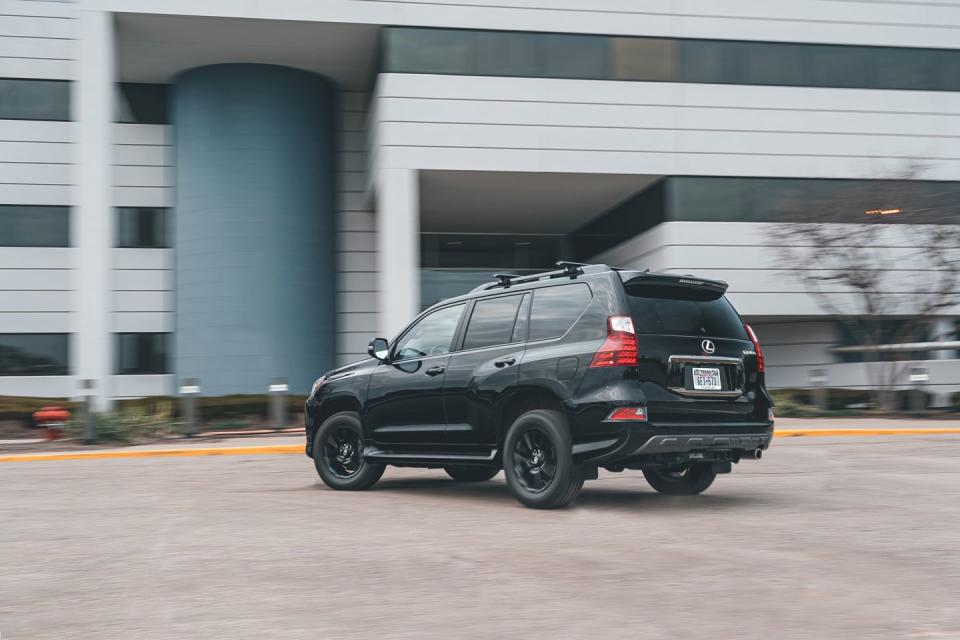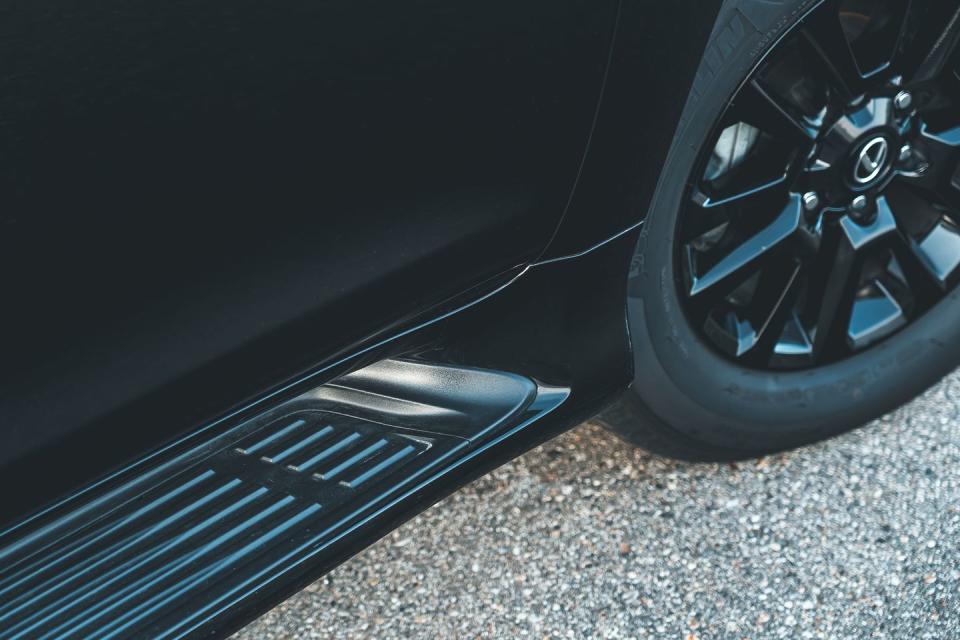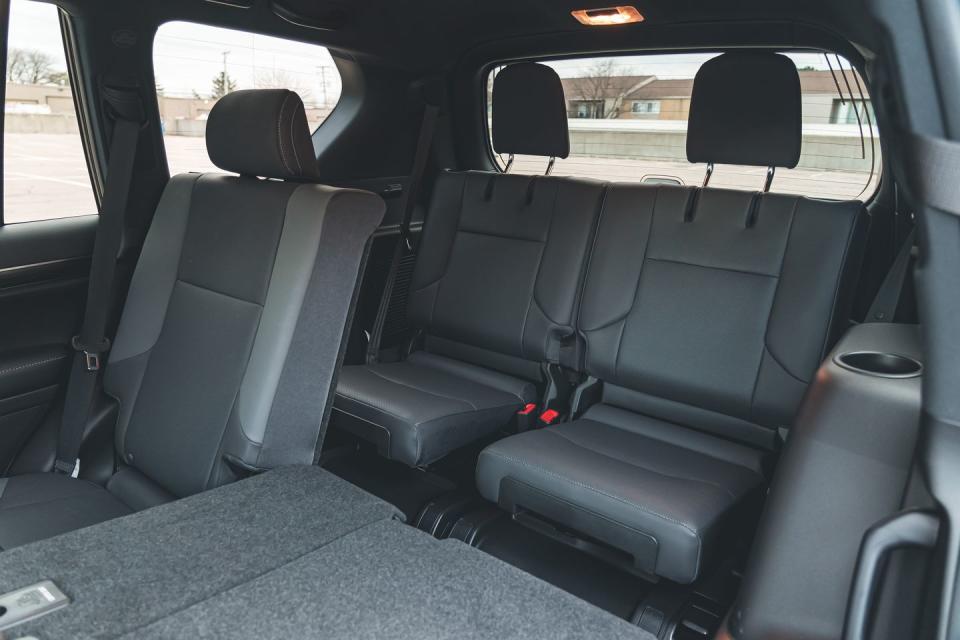Tested: 2022 Lexus GX460 Is Old School with a Side of Luxe

The Lexus GX has long been known as a finer 4Runner, an upscale counterpart to Toyota's sturdy, traditional mid-size SUV. The two share many of the same strengths and weaknesses, most of which are tied to their body-on-frame construction and their advancing age (the current-generation GX dates back to 2010).
There are significant differences between the two, however, and they extend beyond their exterior styling and interior design. Mechanically, the biggest upgrade the GX enjoys over the 4Runner is a V-8 engine in place of the Toyota's V-6. The Lexus's 4.6-liter V-8 spins with a creamy smoothness that the 4Runner's V-6 can only look on with envy, its demeanor exactly matched by the standard six-speed automatic (one more gear than the Toyota's five-speed auto) that delivers almost imperceptible shifts.

With 301 horsepower and 329 pound-feet of torque, this V-8 also offers meaningful additional grunt versus the Toyota's 270 horses and 278 pound-feet. That's reflected in its 60-mph time of 7.2 seconds, which is a half-second better than the 4Runner TRD Pro can manage. And yet, you still wouldn't characterize the GX as quick. The V-8's torque peak doesn't arrive until 3500 rpm, and it takes a good stab of the accelerator to get there. This is the rare vehicle that, when you look down at the speedometer, you often find yourself driving slower than expected.

Look beyond these two cousins, and you can see the advantage that competitors' turbocharged engines have. A turbo-four-cylinder Ford Bronco four-door hustles to 60 mph in 6.5 seconds, a similarly configured Jeep Wrangler does so in 5.8, and a six-cylinder Land Rover Defender 110 manages 6.3. All three also beat the GX460's quarter-mile time of 15.7 seconds at 89 mph.
The big V-8, an automatic with just six forward speeds, and the body-on-frame construction (our test car weighed in at 5264 pounds) all take a toll on the GX's fuel economy. The GX460's EPA estimates of 15/19 mpg city/highway are barely worse than the six-cylinder 4Runner (16/19), but you'd spend less filling up a size-larger Ford Expedition (16/22 mpg) or Chevy Tahoe 5.3L (15/20 mpg). We averaged 18 mpg in our highway fuel-economy test.
The V-8 does make for a beefy, 6500-pound towing capacity, however, which tops the 4Runner's 5000 pounds and far exceeds that of most crossovers. Don't look for any trailer-reversing-assist technology though—it's not here.

Four-wheel drive is standard and includes a two-speed transfer case with low range and a locking center differential, providing a solid basis for off-road exploration. An available Multi-Terrain Monitor ($800) brings a full suite of cameras to bear, and the optional Off-Road package adds skid plates, various terrain modes, and Crawl Control. The net result is considerably more off-pavement ability than the typical three-row crossover.
For on-pavement driving, there's adaptive cruise control (but no lane-keeping assist), forward collision warning with pedestrian detection, blind-spot monitoring, and automated parking. The Luxury trim gets adaptive dampers, which allow the driver to toggle among Normal, Comfort, and Sport modes. The latter is certainly a misnomer, but it tightens up body motions to a slight degree. All GX models come standard with what Lexus calls a Kinetic Dynamic Suspension System, which links the two-piece front and rear anti-roll bars and goes some way toward quelling the GX460's listing in corners, although there's still plenty of dive under braking. The cushy suspension tuning and the tires' tall sidewalls round off sharp-edged potholes, but the solid rear axle will bounce around over bumpy sections. We recorded a modest 0.74 g of lateral grip in a GX460 Black Line, as well as a 180-foot stop from 70 mph, which is on the long side.

The GX460's interior environs and materials are clearly a cut—or two—above those in the 4Runner. The top Luxury trim boasts semi-aniline leather while the Premium and new Black Line models use the brand's NuLuxe synthetic hides, and all versions get real wood accents. It's a bit of a climb up to get inside, but running boards are standard. Accommodations in the first two rows should engender no complaints, but the solid rear axle raises the floor in the cramped rearmost bench, putting taller occupants' knees at chest level.
The console-mounted Lexus remote touchpad provides imprecise operation of the infotainment display screen, but there's not much reason to use the touchpad. The display is within easy reach and has touchscreen operation. The screen was enlarged to 10.3 inches this year and navigation is newly standard, though the graphics still pale next to most smartphones. One old-school element we're glad to see is the audio system's volume and tuning knobs. However, they're easily confused with two similarly sized knobs that are directly above them on the center stack and therefore an easier reach—those operate the DAC (Downhill Assist Control) and select the four-wheel drive's high and low ranges. At the very least, their positions should be swapped. The GX's audio system also still welcomes CDs, although Android Auto and Apple CarPlay are now supported as well, along with Amazon Alexa.

Whereas its Toyota relative has a traditional liftgate, access to the GX460's cargo hold is via a side-hinged door. This arrangement precludes having the convenience of power opening/closing and is less than ideal for curbside loading (it hinges on the right), although the rear glass can flip open independently. Sliding bulky items into the cargo area is made difficult because the load floor steps up several inches. The cargo hold also is smaller than most three-row crossovers, with a maximum of 26 carry-on-size boxes with the rear seats folded flat (a Land Rover Defender stows 32 and a Ford Explorer holds 31). And with the third-row seat in use, luggage space all but disappears, leaving barely enough room for a couple of school backpacks.
Families that would regularly use the third row or make heavy use of the cargo area would likely be better served by a mid-size three-row crossover—most of which would also get better fuel economy. The GX, like the 4Runner, is more for those seeking traditional SUV ruggedness and off-road ability. The GX and the 4Runner are closely related enough that the GX benefits from the same reputation for longevity that helps the 4Runner command impressive resale value. And yet, the GX has plenty to differentiate it from its Toyota cousin: not just its own exterior styling and a higher-end interior, but also an upgraded powertrain. Those differences help justify the GX—with base prices ranging from $56,700 to $66,210—and its extra spend over the Toyota.

You Might Also Like

 Yahoo Autos
Yahoo Autos 